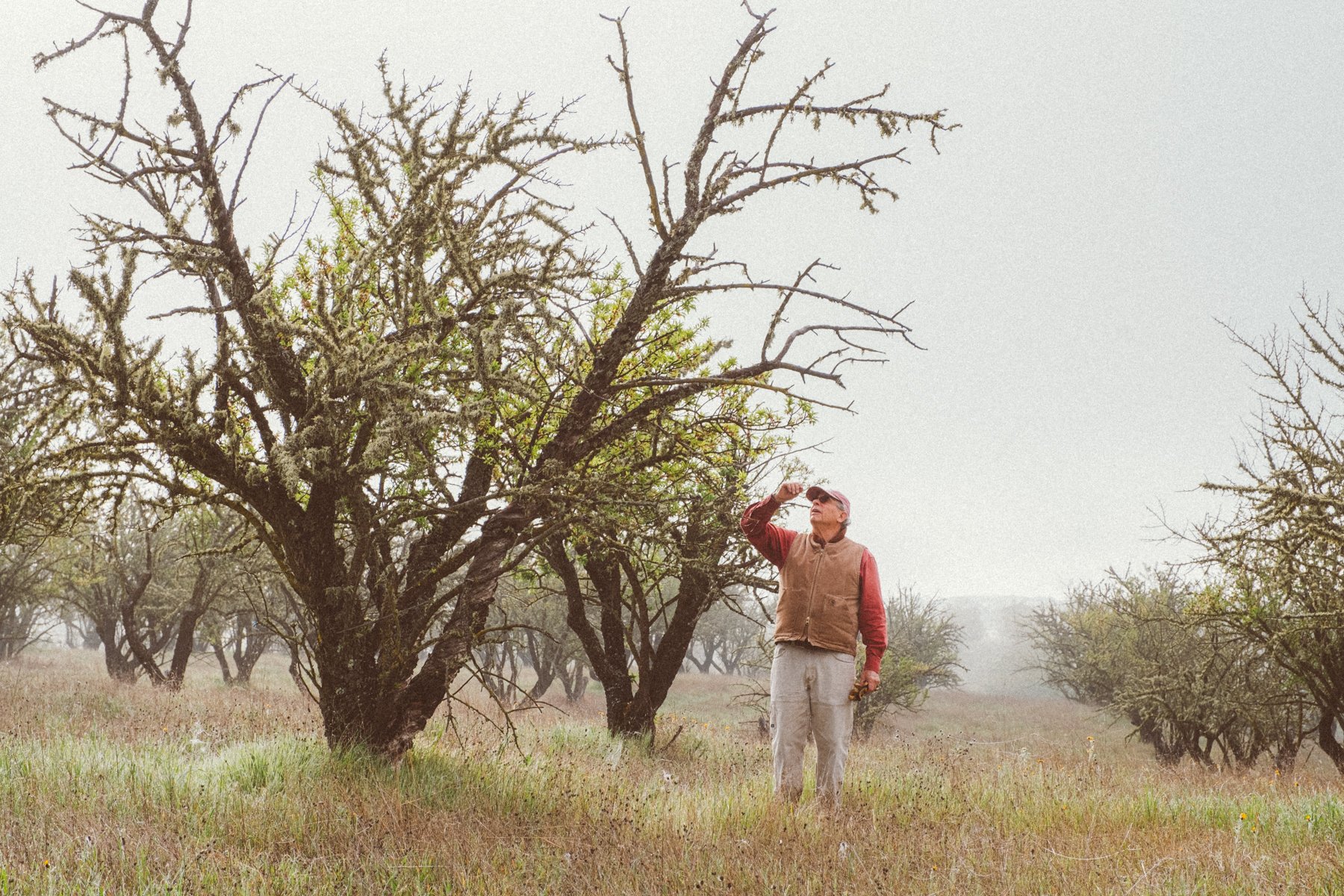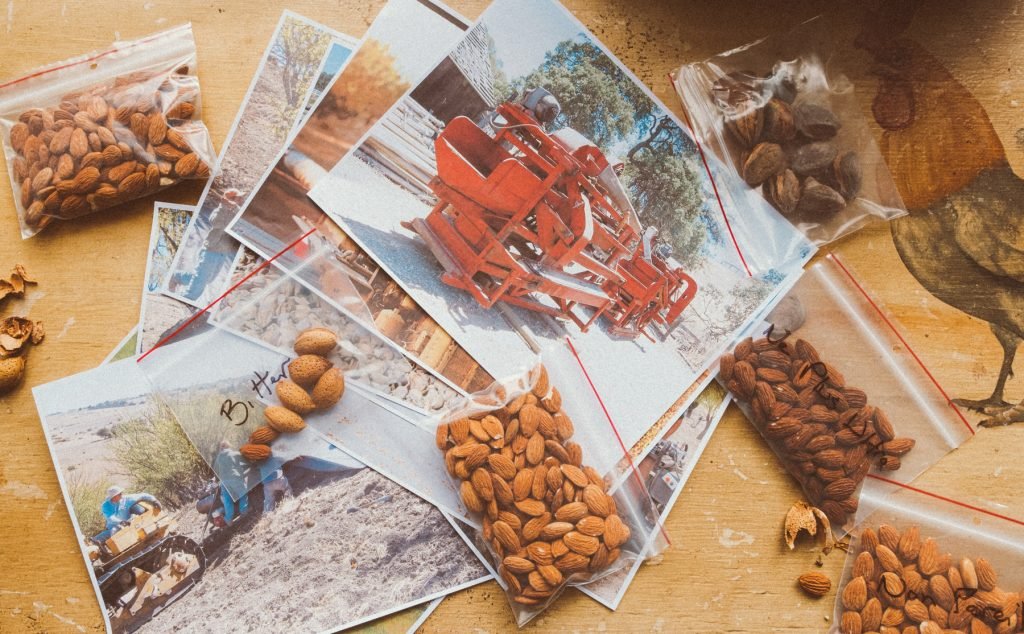
Growing Hope
Rusty Hall, a fifth generation almond farmer, lives just outside Paso Robles on a 93-acre parcel that he inherited from his father in 1974. The Hall family began ranching and farming in the area in the mid-1800s. By the 1920s, Paso Robles, then one of the most productive almond growing regions in the nation, became known as the “Almond Capital of the World.”
The almonds that Rusty and his family grew were not your standard commodity varietal like those commercially grown in the Central Valley because unlike those, which require heavy amounts of irrigation to keep them productive, Rusty’s orchard was all dry farmed. Dry farming is a method typically used in drought-sensitive locations or arid regions, which relies on seasonal rainfall as the primary, or only, irrigation. Without the benefits of year-round irrigation, dry farming tends to produce far lower yields. However, the result is fruit that exhibits more pronounced variety characteristics such as higher sugar concentrations or hardier trees or vines. This is because the plant, tree or vine works harder to produce less. Remember the first time you tasted a dry farmed watermelon or heirloom tomato? Yeah, it’s like that.

Rusty’s family dry farmed their orchard until the last commercial crop was harvested in 2015. By that time federal regulations on almond growers, processors and the almond industry as a whole made it no longer viable or even legal for Rusty to sell his almonds directly to consumers.
How To Milk An Almond
The almond industry is regulated by what’s called a federal marketing order, which was first introduced during the Great Depression as a way to help stabilize farm product prices. By design and according to the Almond Board of California, federal marketing orders are created to “regulate and promote the marketing of commodities.” The intention is to organize growers, processors and distributors in a way that leverages their collective resources to have the greatest impact on all stakeholders. Remember the “Got Milk” advertising campaign? That was funded by a similar program.

A federal marketing order empowers the organizing body for a particular crop, and in the case of local almonds, we’re talking about the California Almond Board. “They can’t set prices, but they can regulate the quantity going into the market, which gives them an almost cartel-like authority over the almond industry,” says Rusty. He elaborates, “If the price gets too low, the Almond Board can direct all almond growers to take their product out of the market, and the board can direct funds to subsidize any losses experienced by the growers.” By controlling pricing though managing supply, the California Almond Board effectively controls the entire life cycle of the product from grower to consumer, thus ensuring the grower can get the pricing they need to stay viable. Doing so also regulates the processing of the product, ensures safe manufacturing practices and manages the products’ eventual entrance into the market through licensed brokers.
So what does all of this regulation mean for the consumer? Simply speaking, because the pricing of a raw almond is highly controlled, the value is not going to come from producing the highest quality raw almond possible. The return comes from processing the commodity into value-added products like salt-roasted, smoked or seasoned almonds, almond-based energy bars, trail mixes, extracts and the poster child for “big almond” product development — almond … “milk?”
That’s One Sweet Pivot
While this might be a better way of doing business for “big almond,” unfortunately the industry consolidation makes it impossible for smaller growers, like Rusty, to grow and sell their almonds directly to consumers. Like we’ve heard all too often, when it comes to the production of agricultural products, it’s all about economies of scale, and these economics typically favor larger industrialized processes, not small farmers — a fact that motivated Rusty to lean even harder into the production of his value-added almond products. His orchard might not be able to compete in the grocery store with commercially grown almonds, but his brittle certainly can. Enter Rusty’s popular Central Coast brittle brand, Paso Almonds.

Made of just three ingredients, the brittle is really that simple; but for the aspiring homemade brittle maker, it would be a mistake to assume that this means a good brittle is a simple product to make. As with most culinary techniques, having fewer ingredients at your disposal means far less room for error.
“We process our almond brittle in 22-pound batches,” explains Rusty. By keeping the batch size relatively small, Rusty and the team can maintain the precise time and temperature requirements necessary to produce a brittle that has the perfect texture and flavor. This is not the brittle your grandmother used to make that was just as likely to taste like stale almonds as it was to rip out a molar. Sorry, Grandma, but Rusty’s brittle is better. Much better.
Rusty perfected his recipe over 20 years ago in his home kitchen. He made small batches and passed them out to his friends around the holidays. People liked his recipe so much that in 1992, he took some of the brittle to the San Luis Obispo Farmers’ Market and quickly sold out.
A few things have changed since then. He now has several other products and no longer rents space in catering kitchens. Instead, he has his own manufacturing facility in San Luis Obispo proper. Still, many aspects are the same— each batch is still processed almost entirely by hand — cutting the butter, roasting the almonds, mixing into the caramelized sugar, pouring the confection out onto the tempering table, portioning the candy and then finally packaging it for distribution. This is as “handmade” as it gets, and one can truly taste the attention in each bite.
Dig into Paso Almonds brittle and taste the smokey flavor of the toasted almonds more than the sugar. It’s a pleasant surprise, especially if you’re not typically a candy muncher. For all you savory types, the Sweet Hots candy (almonds, butter, sugar, chipotle, salt), is a wholly satisfying umami-rich snacking experience, with the perfect balance of sweet, savory and “Whoa! Gimme some more of whatever that was!”

]Think Globally, Grow Locally
While speaking to Rusty about the future of the local almond industry, walking through his orchard, it’s difficult not to feel inspired by his outlook. Before the vines, Paso had orchards, and if you ask Rusty — the season is just right for planting the next generation of boutique growers. Modern growing and harvesting techniques can create more efficient systems that would make for more productive and profitable dry farmed orchards.
Reintroducing the dry farmed Paso almond into the local foodshed as the healthy, luxurious and standalone delicious raw food product that it is could cultivate new appreciation for local boutique growers. And while Rusty has no interest in competing with the commercial almond products, he hopes to create an entirely new segment of the market. After one taste of a dry farmed Paso almond, you’ll know that Rusty is on to something.
“There is tremendous value in the almonds grown in this area,” says Rusty. “They are a far superior product than what is commercially grown in the valley. My hope is that my family’s almond growing legacy will attract a new generation of growers and investors with the energy and resources to put Paso back on the map for large-scale commercial dry farming of almonds as well as for small boutique growers like this one.”
He may be standing in the middle of an orchard, but he’s certainly not missing the orchard for the trees.
* * *
Paso Almonds can be ordered at pasoalmonds.com or at these retailers:
North Coast: Hearst Ranch Winery, Cayucos Pharmacy, Linn’s Gourmet Goods, Los Osos Rexall Drug & Gift
Paso Robles: General Store Paso Robles, SLO Sweets, Calcareous Vineyard, Robert Hall Winery, Castoro Cellars
San Luis Obispo: Mama Ganache Artisan Chocolates, California Fresh Market, Mint + Craft, SLO Sweets, SLO Food Co-Op
South Coast: See Canyon Fruit Ranch, California Fresh Market, Avila Valley Barn, Rutiz Family Farms, Hayashi Vegetable Stand, DePalo & Sons

